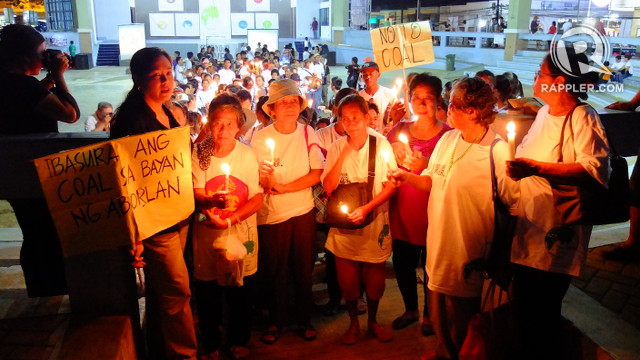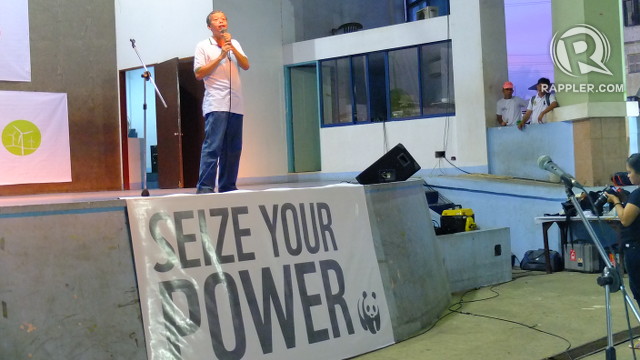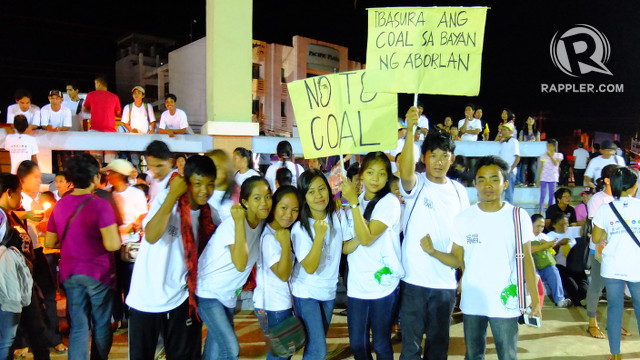SUMMARY
This is AI generated summarization, which may have errors. For context, always refer to the full article.
PUERTO PRINCESA, Philippines – Palawan needs energy, and it needs it now, said Palawan Provincial Advisor for Energy Caesar Ventura to around a hundred Palaweños gathered in Mendoza Park, in the provincial capital Puerto Princesa on Tuesday, October 22.
It was the eve before the start of consultations for the province’s master energy plan. The goal is for the province to be 100%-powered by renewable energy and reduce electricity costs for the entire province.
The plan is long overdue. Palawan, an emerging tourist destination known for its natural wonders, is besieged daily by brown-outs and black-outs that sometimes last as long as 10 hours. The island is not connected to the national grid and is dependent on bunker or diesel fuel shipped in from other countries.
Around 60% of barangays in the province have no power, said Ventura, while those who do pay a high price, literally. Electricity here costs P12 per kilowatt/hour (kW/h) compared to the Metro Manila rate of P6/kW/h.
But Palawan’s exclusion from the national grid may be a blessing in disguise: it means Palawan can restart from scratch and isn’t bound to follow the fossil-fuel-dependent energy models used in other parts of the Philippines.
This, combined with Palawan’s pristine ecosystems, makes the province the perfect experimental ground for renewable energy in the Philippines.
“Palawan is so much better off than the rest of the Philippines. Palawan is the last ecological frontier. It can prove if we can live sustainably. It can be a model to follow,” said World Wide Fund for Nature Philippines CEO Lory Tan.
Use Malampaya for renewable energy
Renewable energy is energy that comes from sources that are continuously replenished such as sunlight, water, wind, tides and geothermal heat. It is seen as an alternative to fossil-fuel-based energy like coal and petroleum because it emits less greenhouse gases, produces less toxic or ecologically-hazardous chemicals and is more flexible because it uses readily available resources.
The technology is also growing and getting cheaper and cheaper, said Tan.
Around 16% of the world’s energy consumption now comes from renewable resources. Wind power, already widely used in Asia, Europe and the United States, is said to be growing 30% annually. At least 30 countries use renewable energy to provide more than 20% of their energy needs. Countries like Iceland and Norway almost totally rely solely on renewable energy for their power supply.
In 2011, 40.6% of the primary energy mix in the Philippines came from renewable resources, according to a Department of Energy report. Geothermal energy accounted for 21.7% of this while biomass contributed 12.4%.
Ventura explained to his fellow Palaweños that renewable energy is the road Palawan must take if it is to develop and prosper.
For example, a proposed hydropower project is expected to generate more jobs per megawatt than a proposed coal plant to be built by DMCI Power Corp, located in the municipality of Aborlan. It can save an estimated P750 million in fossil fuel costs and avoid 26,000 tonnes of carbon emissions yearly.
Renewable energy can also free Palaweños from the clutches of independent power providers (IPPs) who jack up electricity costs even as they use funds from the Malampaya natural gas project to subsidize costs.
“The IPPs here, they use up funds from Malampaya for their subsidy. They benefit. They borrow capital expenditure to put up their power plants. Who pays the amortization? The consumer, through the interest,” said Ventura.
What he would like to see happen is for part of the controversial Malampaya fund to be used to build renewable energy plants in Palawan.
“What we want is to get Malampaya funds and put up our own renewable energy facilities. That could pay for our capital expenditures. If we get the Malampaya fund, the law says to use it to lower the cost of electricity. We will have almost P80 billion to do that,” he told Rappler.
The Malampaya natural gas project, the country’s single biggest foreign investment, has been operating off the shores of Palawan for 13 years and has collected around P170 billion in revenue. It is expected to earn royalties of up to US$10 billion in the first 20 years of operations. (READ: ‘No more cash left’ of Malampaya fund)
Based on Republic Act 7160, or the Local Government Code, if a natural resource is developed and utilized, the local government unit where it is located “is entitled to an equitable share of the proceeds.”
Specifically, the law entitles Palawan to “40% of the gross collection derived by the national government.” However, the national government, under the administration of Gloria Macapagal Arroyo, claimed that Malampaya is not within the jurisdiction of Palawan since it is beyond its 15-kilometer municipal waters.
With no final decision made by the Supreme Court on the matter, an interim decision was reached in 2005 which allowed Palawan to receive half of the 40% it is supposedly entitled to. But groups continue to criticize the agreement saying it reduces Palawan’s share from 40% to 20%.
Arms wide open for investors
But Ventura is pursuing another track to achieve his dream of a renewable-energy-based Palawan: The provincial government is now opening its arms to investors willing to help Palawan make the big switch.
“We’re trying to attract investors. We’re making a one-stop-shop for investors. We call it the Investment Promotion Board. Right now, we’re just finalizing the implementing rules and regulations but it should be ready as soon as possible. By next month, hopefully,” he said.
The initiative seeks to make life easier for investors by reducing red tape and bureaucracy and by providing incentives like tax holidays.
Palawan needs all the help it can get because unlike traditional energy sources like coal, renewable energy facilities are more costly.
It costs a minimum of US$3 million to produce one megawatt of electricity from renewable sources, said Ventura. The entire Palawan needs at least 20 megawatts, which means expenses will reach up to US$60 million.
He said the Palawan government has accepted many applications of potential investors but has yet to receive an application from a “serious investor,” one with sustainable concrete plans and enough funding. But with the imminent finalization of their incentive program, he hopes more will come.
Tan, who leads WWF-Philippines efforts to help Palawan develop its renewable energy plan, is optimistic about the prospect of investors. In fact, he said he knows of an investor interested in putting up a solar energy farm that will sell electricity at a significantly low rate of P9 per kilowatt/hour; the cost will go down to P6.50 per kilowatt/hour after a few years in operation.
The crowd of Palaweños gathered in Mendoza Park, a mix of young and old, know what they want.
They hold up posters opposing the DMCI coal plant in Aborlan. They hold up candles, despite the bright electric lights in the plaza, to allude to the brown-outs they have to endure almost everyday. The students present can recite the different forms of renewable energy and tell them apart.
Many in Palawan believe in renewable energy. But for renewable energy to take off in the province, someone must first believe in Palawan. – Rappler.com
Add a comment
How does this make you feel?



There are no comments yet. Add your comment to start the conversation.